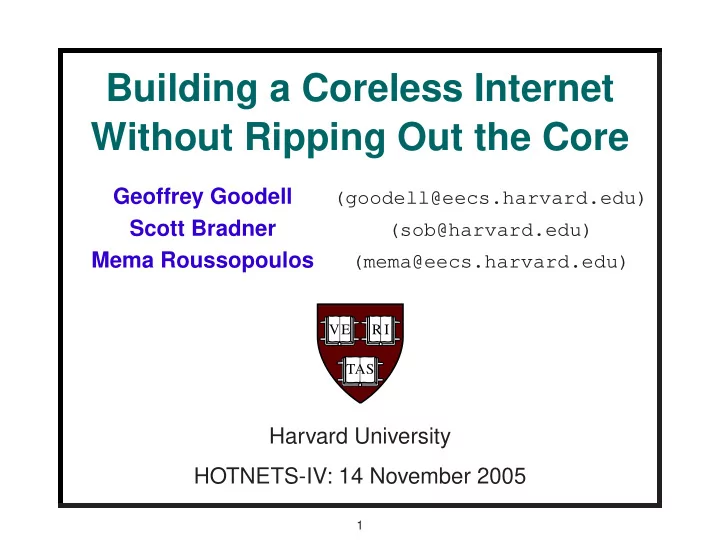

Building a Coreless Internet Without Ripping Out the Core (goodell@eecs.harvard.edu) Geoffrey Goodell (sob@harvard.edu) Scott Bradner (mema@eecs.harvard.edu) Mema Roussopoulos VE R I TAS Harvard University HOTNETS-IV: 14 November 2005 1
The Dream • All clients have access to all resources. 2
The Reality • Access to network resources is a function of location within the topology. 3
Blossom Approach • A peer-to-peer overlay network for sharing perspectives . 4
Blossom Vision • A Coreless Internet: the meaning of names and addresses is a function of their context. 5
“The IP suite imposes a single networking model and addressing scheme over the many different underlying network types it supports... Although helpful for a number of years, while the network was undergoing its initial ‘big bang’ phase, the approximations in the model are now becoming too out-of-step with reality .” — Jon Crowcroft et al., Plutarch, 2003 6
“Without consensus, some experts say that countries might move ahead with setting up their own domain name system , or DNS, as a way of bypassing Icann. “The United States argues that a single addressing system is what makes the Internet so powerful , and moves to set up multiple Internets would be in no one’s interest.” — Tom Wright, “EU Tries to Unblock Internet Impasse.” The New York Times, 30 September 2005 7
Some Types of Fragmentation • Firewalls (Security) • NAT – Network Isolation (Management) – Perception of Address Scarcity (Business Model) • Others : Content Filtering, Multiple Namespaces (Political), Anycast (Efficiency), etc. 8
The Inherent Conflict • Homogenization promotes universal access and consistency • Fragmentation provides distributed management and location specificity • Both are essential to the success of the Internet 9
Blossom Central Principles • [1] Eliminate access restrictions derived from how an observer is connected to the network. • [2] Allow an observer to select a perspective from which to view and access network resources. 10
What We Gain 11
What We Gain [1]: Locality Multiple services with the same name may coexist within different local namespaces (meaningful names within a local space). 12
What We Gain [2]: Universal Access If A can talk to B and B can talk to C, then B can talk to C on behalf of A (circumvent technical barriers). 13
What We Gain [3]: Distributed Management Adding a network and its abundance of resources to the system need not require specific allocation of names, anddresses, or routing from centralized authorities. 14
What We Gain [4]: Deployability • Must function in the absence of explicit participation of service providers: – Network access providers (ISPs) – Content providers (legacy Internet services) • Must provide substantial benefit in the absence of widespread adoption • Must require minimal (preferably zero) modification to OS or application software 15
Accessing a Resource • Our implementation uses Tor to build circuits. 16
Blossom Setup 17
Establish persistent connection 18
Publish to directory server 19
Clients can now access Resources 20
Coreless Approach: LOCAL directory servers 21
Directory Propagation (Control Plane) 22
Design Tradeoffs (What We Lose) • New Namespace Constraints. – Do we need globally unique identifiers? – Do we need a new DNS? • New Discovery Constraints. – Request forwarders by attributes rather than name • New Scalability Constraints. – Directory Size. – Control Messages. 23
Empirical Questions • How far can Blossom scale... – ...before connection latency becomes intolerable for users? – ...before directory sizes become unmanageable? • What can we do to minimize the size and frequency of control messages? • How can we measure the performance of our transport mechanism (e.g. Tor)? 24
Philosophical Questions • What do we lose by building circuits rather than sending independent datagrams? • How can we use Blossom to enhance Internet search? • How can Blossom co-exist with reasonable policies established to restrict access to Internet resources? • How can Blossom co-exist peacefully with unreasonable causes of fragmentation (e.g. oppressive regimes)? 25
http://afs.eecs.harvard.edu/˜goodell/blossom/ 26
Tor Architecture 27
Blossom Architecture 28
Routing Around Obstacles • TRIAD (Cheriton/Gritter 00) – uses globally-unique, hierarchical, DNS-style names to identify networks – names propagate through system using BGP-like advertisements • RON (Andersen et al. 01) – heal network topology by responding faster than BGP – limited to small confederations 29
Indirection • I3 (Stoica et al. 02) – register services with the infrastructure – use a commonly-accessible rendezvous point for connectivity – substantial inspiration for later work 30
Decoupling Policy from Mechanism • FARA (Clark et al. 03) – create associations between nodes without requiring global namespace – provides a general framework for discovery • Platypus (Snoeren/Raghavan 03) – enforce routing policy should on forwarding plane rather than control plane – relies upon cooperation from network access providers 31
Interoperating with Middleboxes • UIP (Ford 03) – argument: hierarchical naming provides efficiency/scalability at the cost of flexibility – create single, flat namespace for accessing UIP-enabled resources • DOA (Walfish 04) – middleboxes no longer considered harmful – create network extension boxes to provide seamless e2e access to DOA resources 32
Non-Universal Namespaces • Untangling the Web (Walfish 04) – DNS hostnames have special value derived from content provided by web services – semantic-free referencing to provide globally-unique self-certifying names – client resolves names to semantic-free tags using third-party service, uses resolved tag to access content 33
Extending NATs • IPNL (Francis/Gummadi 01) – FQDNs as end-system identifiers – stateless routers (part of network-layer infrastructure) – site-centric: requires configuration and deployment of “frontdoors” between private networks and the core 34
Embracing Heterogeneity • Plutarch (Crowcroft et al. 03) – coreless – acknowledges fragmentation as inevitable – requires special configuration of middleboxes to act as gateways between “contexts” – resolves names via a peer-to-peer search 35
Recommend
More recommend